- Author Matthew Elmers [email protected].
- Public 2023-12-16 21:49.
- Last modified 2025-01-24 09:17.
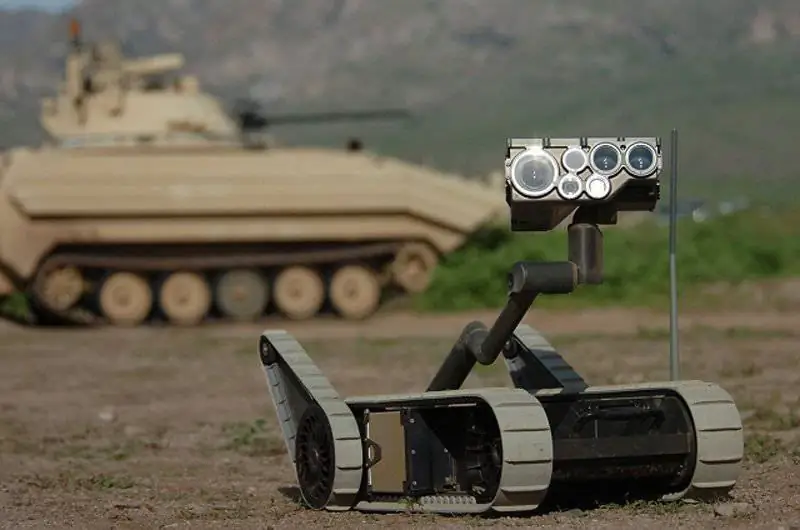
A small robot SUGV (Small Unmanned Ground Vehicle) is inspected at the Dona Ana training ground during exercises conducted by soldiers of the 2nd Combined Arms Battalion in order to test experimental technologies
Everyone is talking about fighting robots. From Hollywood blockbusters to the battlefields of Iraq and Afghanistan, robots are a hot topic and an increasingly expensive piece of military budgets for militaries around the world. But what can you really expect from them? But more importantly, what would we like them to do?
In the pages of science fiction books, robots are often presented as harbingers of the future. In 1962, Ray Bradbury wrote a short story called "I Sing The Electric Body!" In his story, a widow with three children chooses a robot nanny for her children. The robot "grandmother" soon wins the favor of the two youngest children, but only causes a feeling of resentment in the youngest girl named Agatha. "Granny" tries to establish herself in front of Agatha, she demonstrates an act of selflessness, risking her life for Agatha, thereby showing that she can be more human than most people. "Granny" by Ray Bradbury shows robots as heirs to the best of humanity. Today, robots are vital to helping soldiers survive on the battlefield, changing the way wars are fought. Today, to paraphrase Bradbury, you can say: "I am fighting for the electrical body."
Dawn of Land Mobile Robots (HMP)
There are two basic tenets of the modern era that are rapidly changing the way armies wage future wars: first, the ability of humans to transform science into technology; the second is the rate of acceleration with which this transformation is taking place. The first principle is a matter of thinking ability, while the second is a function of the rapid progress of computing power. The combination of intellectual power and growing computing power has created a "brave new world" of military robots for land warfare. The use of military robots in combat represents a "qualitatively new" and often contradictory transformation of war, these robots are not just weapons, they are created to replace human beings.
While 2009 robots are still taking baby steps compared to sci-fi tales, they've already proven their worth in combat. Initial HMP technologies were deployed in the early battles in Iraq and Afghanistan and spread rapidly over the next few years; ground robots have been widely used in explosive ordnance disposal (ORP) operations and countless improvised explosive devices. To date, over 7,000 ground robots have been deployed by the American Armed Forces in their deployment areas, they have become an integral part of combat operations.
At one time, in an interview, retired vice admiral, president of the division for government and industrial robots of iRobot, Joseph Dyer, emphasized the importance of replacing HMP soldiers, at least in some combat situations. “Before the NMP, soldiers went to the caves to check for enemy fighters and military equipment. A rope was tied to them in case something went wrong … so that colleagues could pull them out. With HMP, soldiers can now launch robots first, staying at a safe distance. This is very important due to the fact that half of all losses occur during initial contact with the enemy. Here, the robot is one of those who go first. " Admiral Dyer recalls that in late 2005, the Air Assault Expeditionary Force tested more than 40 new technologies at Fort Benning. “The Minister of Land Forces asked the Expeditionary Force Commander: If you could choose two technologies to apply right now, which one would you choose? The commander responded, Small HMP (SUGV) and RAVEN. When asked why, he replied: among other things, I want to own the situation. I want to have an eye of God (UAV RAVEN) and close personal vision (SUGV) on the battlefield."
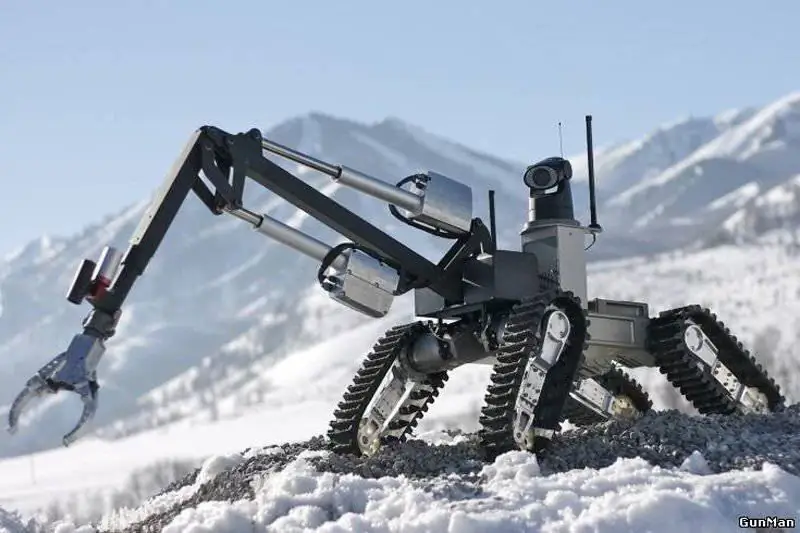
CHAOS robot manufactured by ASI (Autonomous Solutions Inc.) for the TARDEC Armored Research Center, pictured during winter tests
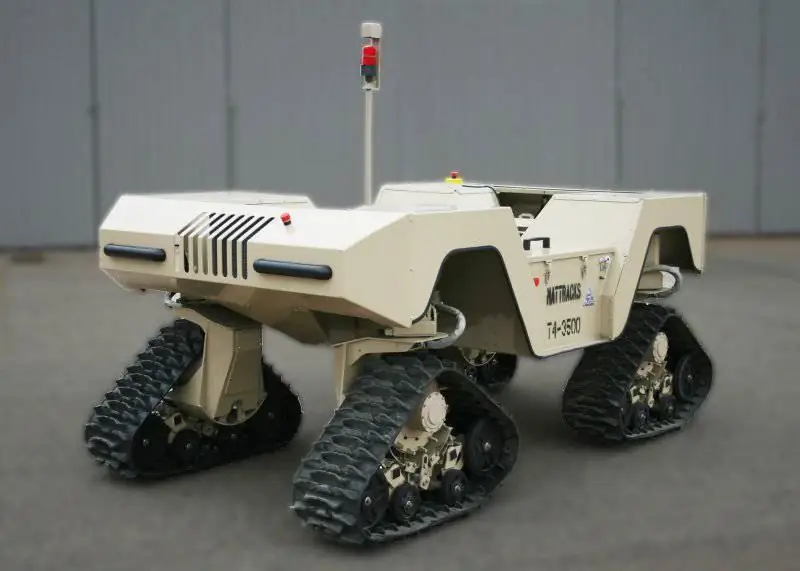
The MATTRACKS T4-3500 robot uses tracked technology that provides mobility and good traction in mud, sand, snow, swamp and tundra. TARDEC worked with Mattracks on the HMP tracked project in terms of chassis and electric drive development

IRobot SUGV can be carried and driven by one soldier
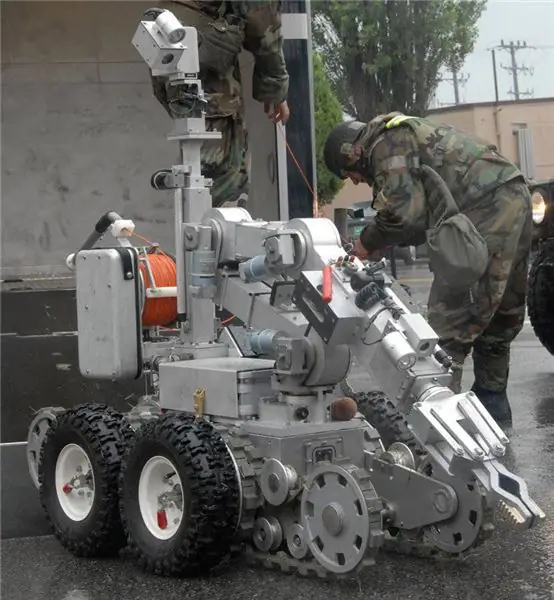
Northrop Grumman Remotec has a wide range of robots for a variety of applications: military, explosive ordnance disposal (ORP), hazardous substances and law enforcement. The family is named ANDROS and includes the HD-1, F6A, Mk V-A1, Mini-ANDROS and WOLVERINE models. In the photo, explosives at work with the F6A model
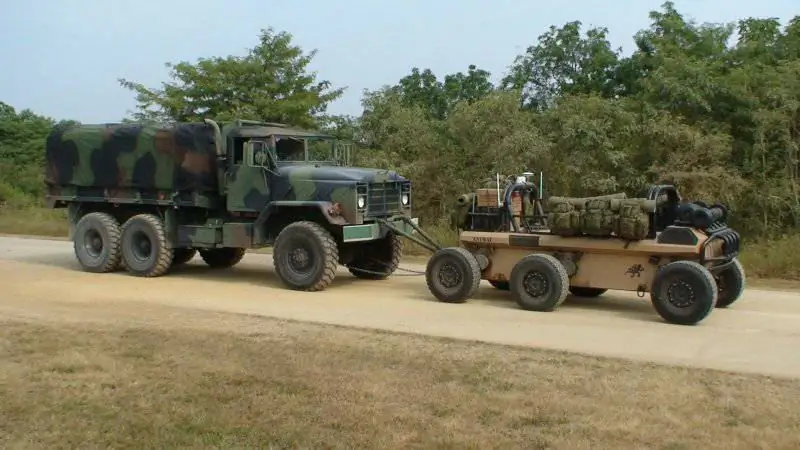
HMP XM1217 MULE-T pulling 5 ton truck during army tests
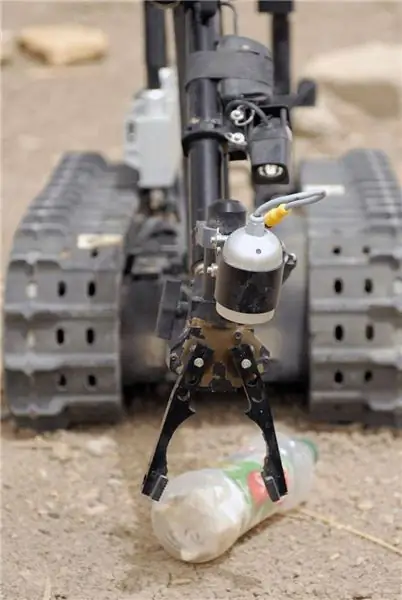
A TALON robot, controlled by a private in the 17th Corps of Engineers of the Iraqi Army, lifts an empty bottle with its grab during a joint exercise in southern Baghdad. TALON was developed by Foster-Miller (part of QinetiQ North America) and has been widely and successfully used in explosive ordnance disposal operations in Iraq and Afghanistan.
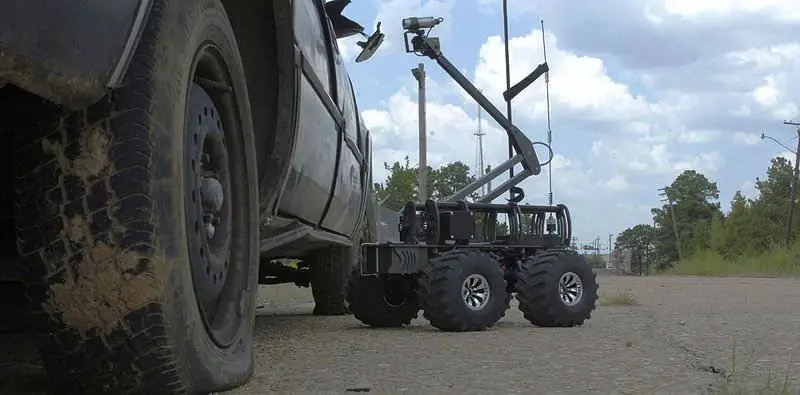
MARCbot IV extends its camera to search for suspicious IEDs
The continuous development of HMP over the past decade, combined with new technologies, has resulted in many robots that have saved many lives and helped achieve operational success in Iraq and Afghanistan. As a result of this timely success on the battlefield, there is an increased interest in ground-based mobile systems across the entire spectrum of ground-based combat missions. The US is currently the pioneer developer of military robots, but this leadership is limited, and many other advanced military forces are supplementing their arsenals with ground robots or planning to do so. Long-term research and development in the United States will focus on the development and deployment of an ever-increasing number of HMPs. A Congressional study (Development and Use of Robotic and Ground Mobile Robots, 2006) identifies HMP as a special area of interest and emphasizes that the military importance of HMP technology is growing rapidly.
HMPs serve two important functions: they broaden the perception of the fighter and they influence the course of action on the battlefield. The first function of NMR is to provide reconnaissance, surveillance and guidance. They influence the course of action in tasks such as countering improvised explosive devices (IEDs), transporting weapons, equipment and supplies, and taking out the wounded.
HMPs can be either remotely controlled (that is, directed by a remote operator or decision maker), or autonomous to a lesser or greater extent (that is, able to work independently within the framework of their task and make independent decisions based on software). Remotely controlled robots are usually controlled through complex wireless communications and typically require a specially trained operator or group of operators to operate in a complex battlefield space. Using radio-controlled HMPs, soldiers can peer around corners in urban combat and reduce their risks from enemy surveillance and fire. Basically, the control distance of modern NMR is 2000-6000 m.
Ground robots are not cheap, and their modern environment often requires more, rather than fewer, personnel. Trained teams usually need to be able to handle the modern generation of HMP. Since personnel costs represent a large part of the costs of any aircraft, the sooner the HWO can operate independently or with little or no control, the lower the costs. NMRs should ultimately replace soldiers, not increase the need for additional soldiers to work with them. The need for operators and maintenance will only increase with the development of HMP.
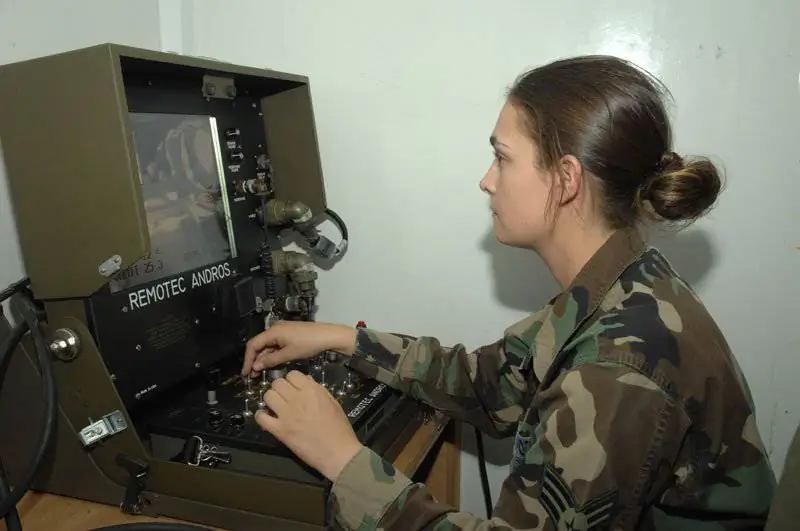
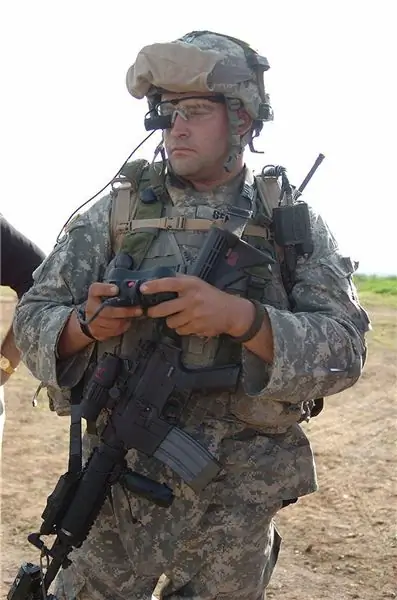
Controlling modern HMPs requires a personal computer or at least a laptop (pictured above is a control workstation for Remotec ANDROS), but for promising small HMPs it will be significantly reduced to a wearable set consisting of a small remote control and a helmet-mounted display
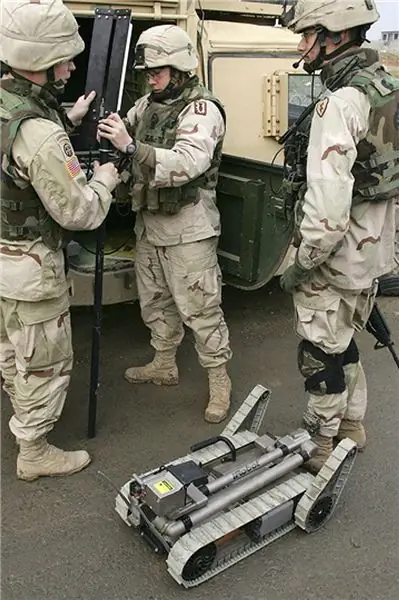
IRobot's PackBot is ready for the challenge of countering improvised explosive devices in Iraq. The company has shipped over 2,525 HMP PackBot series to US aircraft in six batches plus several hundred HMO kits.
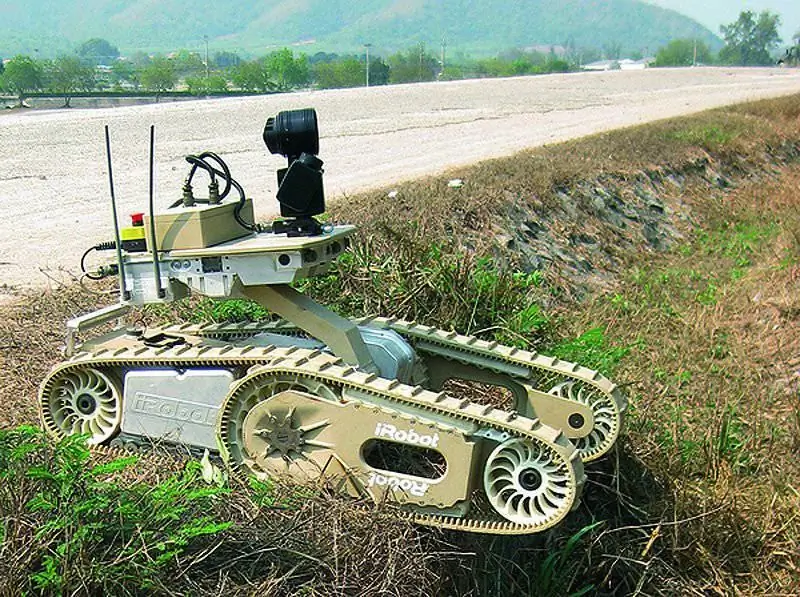
In October 2008, iRobot was awarded a $ 3.75 million R&D contract from TARDEC to supply two WARRIOR 700 platforms. 150 lb (68 kg) and configurable for a variety of hazardous missions, such as bomb disposal, ORP (IEDs / explosives / unexploded ordnance), route clearance, surveillance and reconnaissance. It can also be used to remove the wounded from the battlefield, or in the armed version it can destroy targets from the M240B machine gun. WARRIOR 700 is remotely controlled using an Ethernet radio at a distance of approximately 800 m, but it cannot make independent decisions
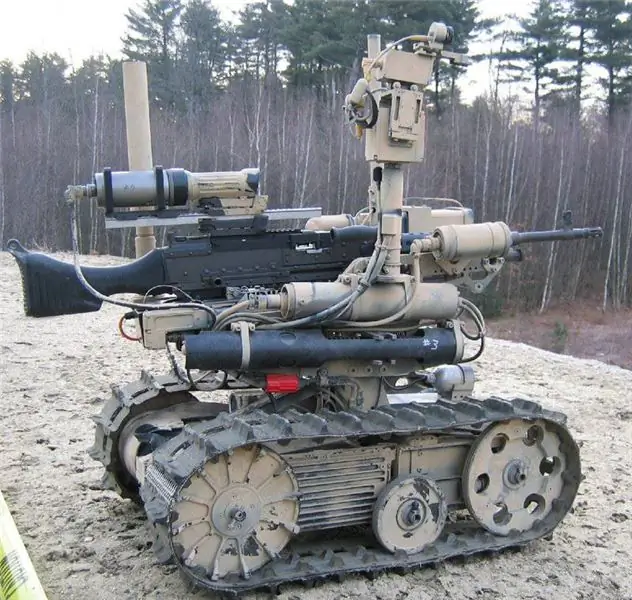
The SWORD (Special Weapons Observation Reconnaissance Direct-action System) variant of the TALON series can have either M240 or M249 machine guns, or a 12.7 mm Barrett rifle for performing armed reconnaissance tasks. Various prototypes of the SWORDS variant were delivered to the ARDEC weapons research center for evaluation, and some of them were later deployed in Iraq and Afghanistan. Additional systems are currently being evaluated by combat units in the US and other countries.
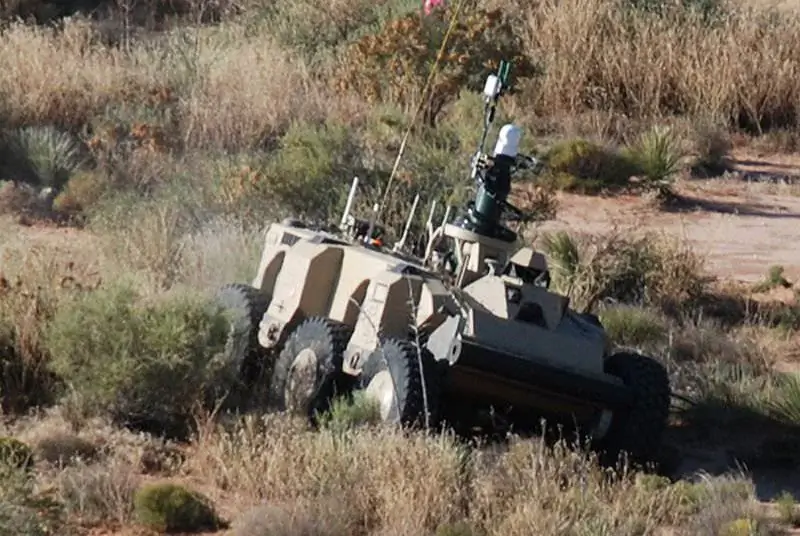
The UGCV PerceptOR Integration (UPI) program is run by the National Robotics Center to improve the speed, reliability, and autonomous navigation of a ground mobile robot. Pictured is НМР CRUSHER, overcoming difficult terrain during tests at Fort Bliss
HMP and the legacy of the US Army FCS program
In the future, there will naturally be more combat robots with better characteristics. At the heart of the US Army's once most ambitious program, the FCS (Future Combat System), for example, were robots as a very important factor in enhancing the combat capabilities of the army. And although the program "ordered to live long" in 2009, the robots developed within its framework, apparently, survived it and continued their technological development. The advantages of HMR on the battlefield are so enormous that the development of remotely controlled and autonomous HMRs continues despite cuts in the defense budget. Former DARPA director Steve Lukasik said: "What is now called advanced systems is basically a robotic addition to ground forces in combat."
The HMP family for the late-in-the-Bose FCS program includes the Small HMP SUGV (Small UGV) and the MULE series. All combined NMPs are the basis for the success of future combat brigades and are important combat components on a par with other manned weapons and components of the armed forces.
The XM1216 SUGV (Small Unmanned Ground Vehicle) Small Ground Mobile Robot is a lightweight, wearable system capable of operating in urban areas, tunnels, sewers and caves or other areas that are either inaccessible or too dangerous for soldiers. The SUGV performs surveillance and reconnaissance, preventing soldiers from entering dangerous areas. It weighs less than 30 lb (13.6 kg) and carries up to 6 lb (2. 7 kg) payload. This load may include a manipulator arm, a fiber optic cable, an electro-optical / infrared sensor, a laser rangefinder, a laser designator, an auto-arm for urban unattended ground sensors, and a chemical / radiological / nuclear detector. The system is portable and serviced by a single soldier and has a variety of operator control units, including a handheld controller, a main wearable controller, and an advanced wearable controller. The SUGV is operated remotely and is not autonomous.
Under the MULE (Multifunction Utility / Logistics Equipment) program, a 2.5-ton common chassis was created with three options to support a dismounted soldier: a transport (MULE-T), an armed mobile robot - assault (light) (ARV-A (L)) and demining option (MULE-CM). They all share the same 6x6 base chassis with independent pivot suspension, hub motors spinning each wheel for superior flotation on difficult terrain and far superior to vehicles with traditional suspension systems. MULE overcomes a step with a height of at least 1 meter, and can cross ditches 1 meter wide, cross side slopes of more than 40%, force water obstacles more than 0.5 meters deep and overcome obstacles with a height of 0.5 meters, while compensating for different payload weights and location center of gravity. All MULEs are equipped with an autonomous navigation system that includes navigation sensors (GPS + INS), perception sensors, autonomous navigation algorithms and obstacle avoidance and avoidance software. НМР can be controlled either in remote mode, or in semi-automatic mode following the leader, or in semi-automatic mode along the route. MULE has the future potential through spiral development and has an open architecture to take full advantage of the rapidly evolving technology.
Built to support soldiers, the XM1217 MULE-T provides the volume and capacity to carry weapons and supplies to support two dismounted infantry squads. It will carry 1,900-2400 lb (860-1080 kg) gear and backpacks for dismounted infantry squads and follow the squad over rough terrain. A variety of attachment points and removable / foldable side rails allow you to attach almost any load, including a casualty stretcher.
The XM1218 MULE-CM will provide the ability to identify, mark and neutralize anti-tank mines using the built-in GSTAMIDS (Ground Standoff Mine Detection System). The XM1219 ARV-A (L) will be equipped with armament (rapid-fire suppression weapons and anti-tank weapons) designed to create immediate intense firepower for a dismounted soldier; the robot is also designed for reconnaissance, surveillance and target acquisition (RSTA), supporting dismounted infantry to determine the location and destroy enemy platforms and positions.
NMR and the future
It seems clear that advanced armies will deploy human and robotic forces when HMP is used for reconnaissance and surveillance, logistics and support, communications and combat. Whenever the issue of robots is discussed, the debate about autonomous control usually "keeps up." The advantages of autonomous robots over remotely controlled robots are obvious to anyone trained for war. Remote solutions are slower than standalone solutions. An autonomous robot must be able to react faster and distinguish its own from the enemy faster than a remotely controlled model. In addition, remote robots require communication channels that can be interrupted or jammed, while autonomous robots could simply turn on and off. Autonomous robots are therefore the next inevitable step in the evolution of military robots.
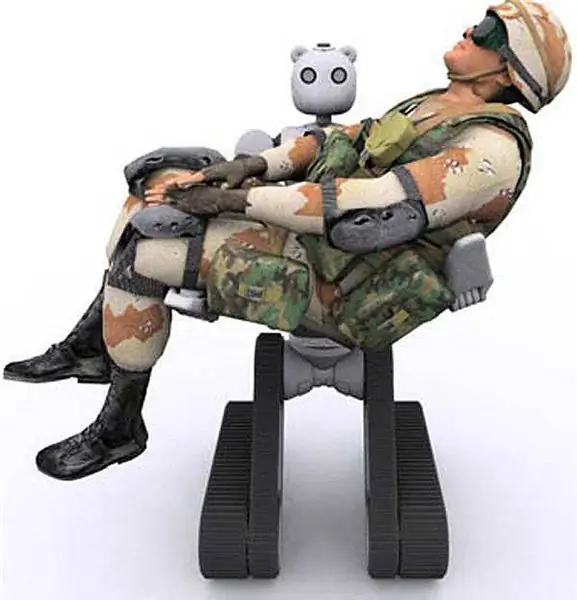
BEAR (Battlefield Extraction-Assist Robot) from Vecna Robotics may someday provide opportunities for robotic evacuation of the wounded. The BEAR is capable of carefully lifting a person or other payload and transporting it over a distance and lowering it to the ground where indicated by the operator. Whether in combat, in the heart of a reactor, near toxic chemical spills, or inside structurally hazardous structures after earthquakes, BEAR will be able to locate and rescue those in need without unnecessary loss of life. Vecna Robotics' BEAR project has won key seed funding in the form of a grant from the TATRC Telemedicine and Advanced Technology Research Center (USAMRMC's Medical Research and Materials Command structure). It is currently fully wireless controlled by one operator, but eventually BEAR will become more and more autonomous, making it easy to operate.
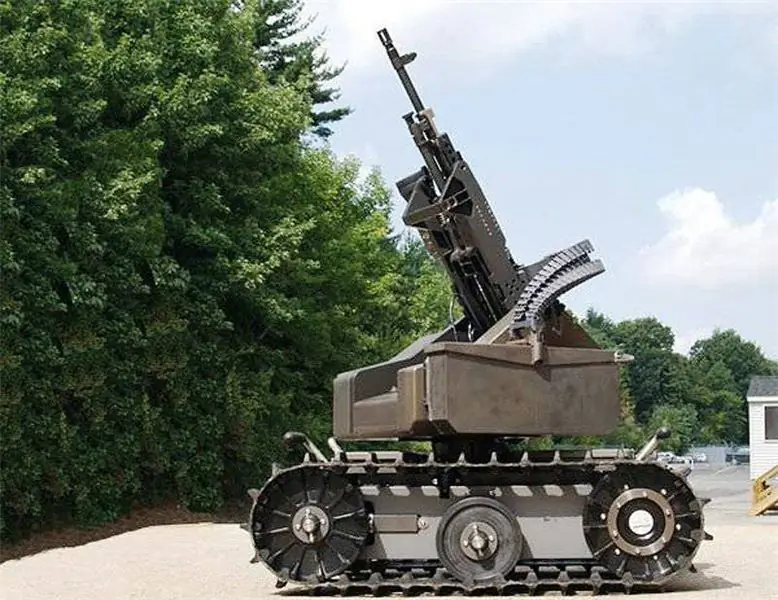
MAARS (Modular Advanced Armed Robotic System) from Foster-Miller as the successor to the SWORD model introduces a new "transformer" modular design. It has a more powerful M240B machine gun and significant improvements in command and control, situational awareness, mobility, lethality, and safety features over its predecessor. MAARS has a new 100 lb rated manipulator arm that can be installed in place of the M240B turret machine gun, literally transforming it from an armed platform to protect its forces into a platform for identifying and neutralizing explosives. The MAARS chassis is a self-supporting structure with easy access to batteries and electronics. Other features include a larger load compartment, more torque, faster speed, and improved braking. The new digital control box significantly improves the monitoring and control functions and situational awareness, which allows the operator to have a greater level of safety. The entire system weighs approximately 350 lbs (158 kg). MAARS and SWORDS are ROVs (remotely operated vehicles) and as such they are not autonomous
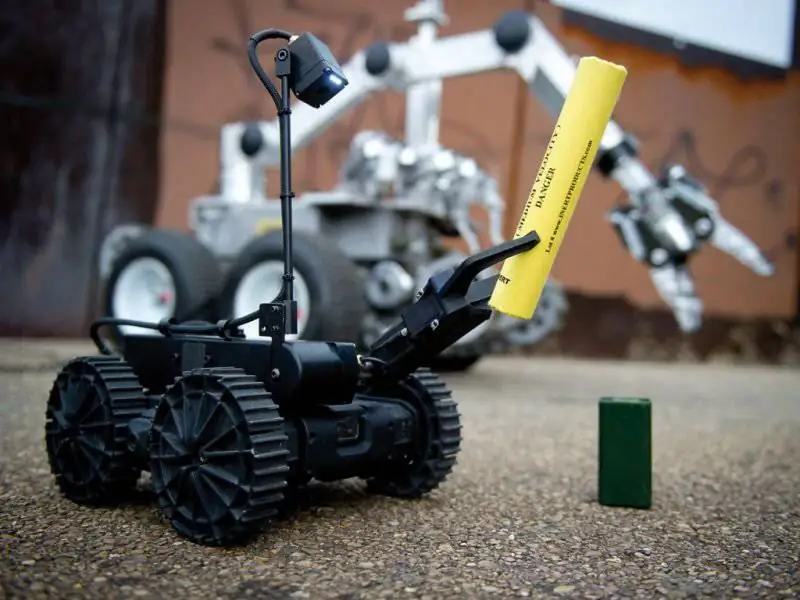
The ARMADILLO from MacroUSA is an extremely compact, portable and drop-down platform ideal for urban environments. The concept of this "abandonment" is to deliver HMP to dangerous places by throwing ARMADILLO into potentially dangerous areas for observation. The small size of the ARMADILLO makes it the ideal companion for soldiers in urban combat. The robot can work in any position if necessary, its dual antenna is mounted on a pivot support that rotates to hold it in a given direction; the antenna can also be folded horizontally for transport and handling. Tracksorb modular wheels have been specially designed to absorb vertical axle forces and traction on uneven terrain and overcoming obstacles. ARMADILLO can also be used as an automatic video / acoustic surveillance device with a digital camera installed
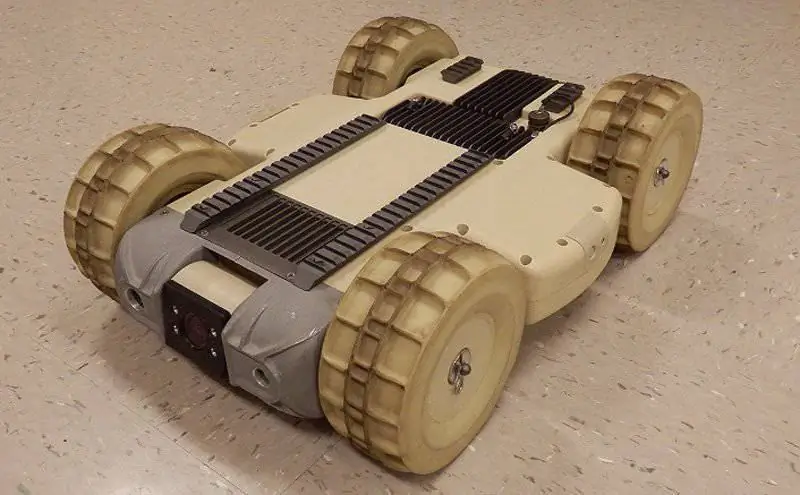
The SUGV DRAGON RUNNER was originally developed for the US Marine Corps by Automatika, which became a subsidiary of Foster-Miller in 2007. Today's base model weighs 14 pounds (6.3 kg) and measures just 12.2x16.6x6 inches. The robot enables users to "look around the corner" in urban environments. It can also be useful in such roles as: security of checkpoints; checking the bottoms of vehicles; exploration inside buildings, sewers, gutters, caves and courtyards; perimeter security using on-board motion sensors and sound detectors; inspection of bus, train and aircraft cabins; intelligence and negotiations during hostage-taking; clearing routes from IEDs and explosive ordnance disposal. Joint Ground Robotics Enterprise has developed four and six-wheeled DRAGON RUNNER models, along with configurable tracked and long-tracked versions. Some promising DRAGON RUNNER robots will have manipulators, others will support additional lifting capacity systems for remote delivery of additional sensor and neutralization equipment, including explosives detection, IED neutralization kits, water cannons, searchlights, cameras and repeaters
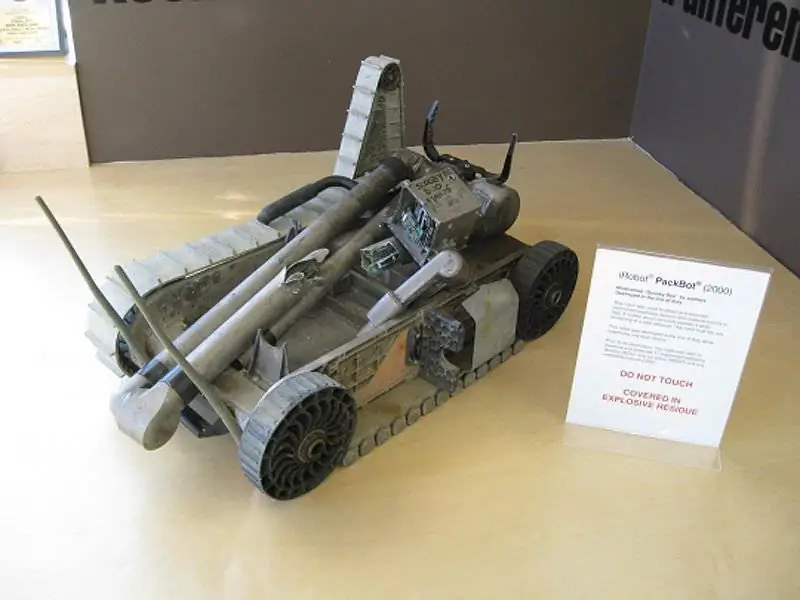
Scooby-Doo pictured in the lobby of iRobot. This SMR tested and destroyed 17 IEDs, one explosive vehicle and one unexploded bomb in Iraq before being destroyed by an IED itself. Soldiers view these robots as members of their team. In fact, when this robot was destroyed, the agitated soldier went to the repair shop with him asking him to fix the robot. He said the robot saved several lives that day. The HMP was already non-repairable, but this shows the soldiers' attachment to some of their robots and their appreciation for the fact that robots save their lives.
In an interview with Big Think magazine, Daniel Dennett, professor of philosophy at Tufts University, Massachusetts, discussed the issue of robotic warfare and the topic of controlling remotely controlled and autonomous robots. He stated that machine control replaces more and more human control in all aspects every day and that the debate, which is better, human control or artificial intelligence solutions, is the most difficult issue we face today. Decision making also opens up one of the hottest debates around the use of robots in warfare.
Some argue that if technology trends continue, it won't last long until most ground robots become autonomous. The arguments for effective autonomous HMP are based on the belief that they will not only reduce friendly casualties in future wars, but also reduce the need for HMP operators and therefore lower overall defense spending. Robots may not be cheap, but they cost less than even more expensive soldiers. The rivalry to build and deploy the most effective autonomous robots for complex combat missions on land, at sea and in the air will accelerate in the years to come. For efficiency and cost reasons, and consequently because thinking ability is combined with computing power, autonomous robots will be developed and deployed in large numbers over the next decades.
Professor Noel Sharkey, an expert on robots and artificial intelligence at the British University of Sheffield, once said that: “Modern robots are stupid machines with very limited sensory capabilities. This means that it is impossible to guarantee a clear distinction between fighters and innocents, or the proportional use of force required by the current laws of war. " He went on to add that “we are rapidly moving towards robots that can decide to use lethal force, when to use it and to whom to use it…. I think we can talk about a period of 10 years."
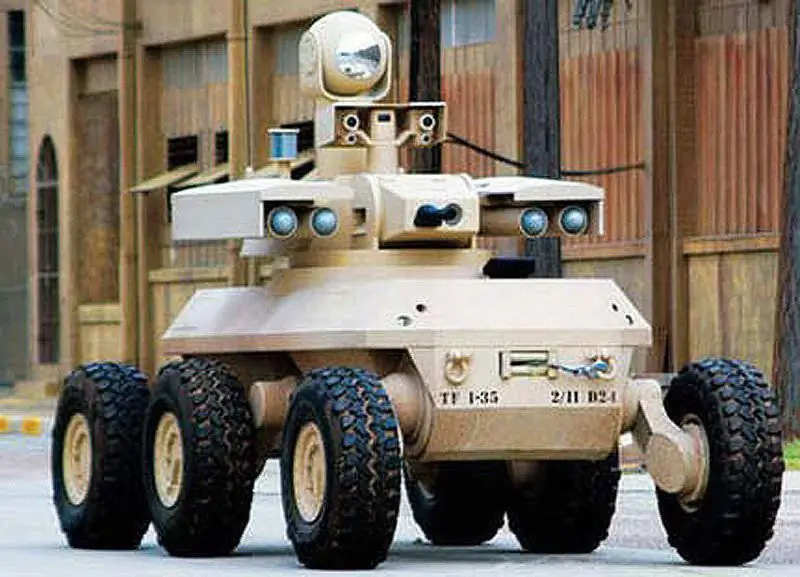
The combat variant ARV-A (L) of the MULE family will have built-in armament (rapid-fire suppression weapons and anti-tank weapons). It is designed to provide immediate opening of fire to support a dismounted soldier, as well as reconnaissance, observation and detection and destruction of enemy platforms and positions
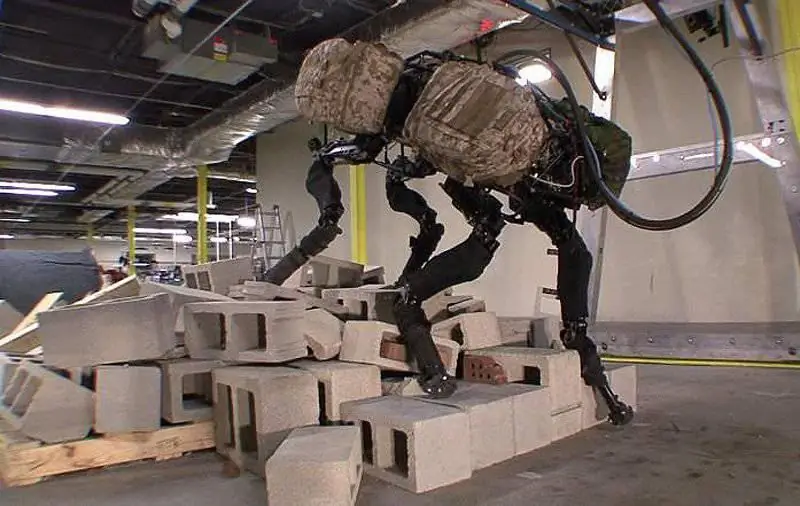
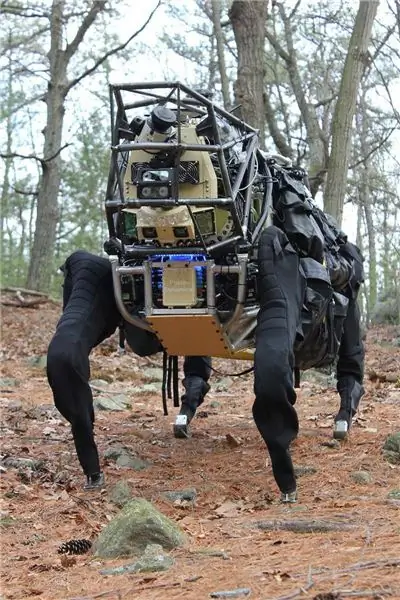
BIGDOG, described by its developers at Boston Dynamics as "the most advanced four-legged robot on Earth," is an all-terrain robot that walks, runs, climbs and carries heavy loads, in essence a robotic cargo mule designed to carry heavy loads for infantrymen on areas where it is difficult for ordinary cars to pass. BIGDOG has an engine that drives a hydraulic control system, it moves on four legs, which are articulated like an animal by elastic elements to absorb shocks and recirculate energy from one step to the next. The size of a small mule, the BIGDOG robot weighs 355 lbs (160 kg) with a payload of 80 lbs (36 kg). The BIGDOG on-board computer controls movement (locomotion), leg servo motors and various sensors. The control system of the BIGDOG robot keeps it in balance, directs and regulates its "energy" when external conditions change. Motion sensors include joint position, joint forces, gyroscope, LIDAR (infrared laser locator) and stereoscopic system. Other sensors focus on the internal state of BIGDOG, monitoring hydraulic pressure, oil temperature, engine performance, battery power, and more. In special tests, BIGDOG ran 6.5 km / h at a trot, climbed an incline up to 35 °, stepped over stones, walked on muddy paths, walked on snow and water, and showed its ability to follow a human leader. BIGDOG has set a world record for walking vehicles for 12.8 miles without stopping or recharging. DARPA, which sponsors the BIGDOG project, launched the next Legged Squad Support System (LS3) in November 2008. It is seen as a system similar to BIGDOG, but weighs 1250 lbs, 400 lbs payload and has a 24 hour power reserve of 20 miles.

Demonstration of the LS3 Robotic Walking System to the Marine Corps Commander and DARPA Director September 10, 2012. Videos with my subtitles
The creation of autonomous combat robots, separating humans from the trigger, and replacing human decision-making with a rule-based system is the subject of much controversy, but as in other areas of technological development, the genie cannot be shoved back into the bottle and the proliferation of autonomous HMP becomes inevitable. If the increasing proliferation of autonomous robots on the battlefield is inevitable, then the debate over the rules for hitting targets that determine when the trigger is pulled is more important than ever. Most likely, the result of this dispute may be the development of a "warrior code of ethics" for autonomous HMPs.
Senior researcher at Brookings Institution and author of Bound to War, P. Singer, told Big Think magazine that you can put codes of ethics into autonomous machines, which will reduce the likelihood of war crimes. Machines, by their very nature, cannot be moral. Robots have no moral boundaries to direct their actions, they do not know how to empathize, they have no sense of guilt. Singer stated that for an autonomous robot, "an 80-year-old grandmother in a wheelchair is the same as a T-80 tank, except for a couple of ones and zeros that are embedded in the program code … and this should concern us in a certain way."
To meet their full potential and be more efficient and affordable, HMPs should become more autonomous, but in the near future, however, robots will remain largely controlled by human operators. Autonomous robots like the GUARDIUM are likely to be assigned certain discrete tasks, such as ensuring security in specially defined and programmed areas (for example, guarding the international airport in Tel Aviv). Most of the robots will remain under human control for many years (do not be afraid of Skynet from the Terminator movies) since artificial intelligence for autonomous robots is still decades away from us.
IRobot CEO Colin Engle said in an interview with CNET News: “You are in a control chain and even if you can tell a GPS-equipped robot to follow a certain path until it reaches a specific position, there will still be a need for human involvement. the goal of deciding what to do when the robot gets there. In the future, there will be more and more capabilities built into the robot, so that the soldier does not have to constantly look at the video screen while someone sneaks around and can create trouble, and therefore we will allow robots to become more efficient. But, nevertheless, there is a need for human participation because artificial intelligence is simply not very suitable in this case."
Until the day when autonomous robots appear in large numbers on the battlefield, HMP will be improved through step-by-step automation, which will facilitate their operation, reduce the required number of soldiers for control, but the right to issue the order will remain with the soldier. Soldiers will use these incredible machines to save lives, gather intelligence, and hard hit their opponents. Like the robot in the Bradbury story. robots are “neither good nor bad,” but they can be sacrificed for human sake and this makes them invaluable. The reality is that robots save lives on the battlefield every day, but armies don't get enough of them.






